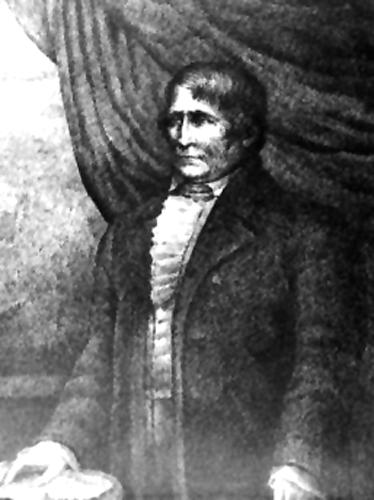JEAN PIERRE CHOUTEAU | THE EARLY YEARS |The Father of Oklahoma
JEAN PIERRE CHOUTEAU | THE EARLY YEARS |The Father of Oklahoma
This is the fourth in a series of articles for Echos From The Past provided by the Grand River Historical Society www.grandriverhistory.com
Jean Pierre Chouteau The Early Years written by Dr. Bruce Howell
We are taught in Oklahoma history that late in the 1700’s, Jean Pierre Chouteau founded a trading post that later became Salina and that ultimately Chouteau was honored by the title “Father of Oklahoma.” What were the circumstances surrounding this honor? School history classes tend to focus on names, dates and places and ignore or brush over other reasons regarding why events occurred. So, it’s important to “humanize” these folks in order to relate to them. Unforeseen situations, politics, acquiring wealth, ego, or simply being at the right spot at the right time also must be considered when we read about icons of history. So to quote Oklahoma’s Paul Harvey, ”This is the rest of the story” or in this case the beginning of the story of how one icon, Jean Chouteau, ended up in Oklahoma.
Either by accident or on purpose, explorers had considerable influence on the development of Northeastern Oklahoma. Early Spanish explorers de Soto and Coronado, and later Frenchmen Claude Du tisne and Bernard De la Harpe crisscrossed the region on missions looking for gold, trade, or water routes to China. They provided information about the region, but really without a thought that the territory might be a nice place to live and raise a family. So the first explorer to indelibly carve his name in Oklahoma history was Frenchman Jean Pierre Chouteau, who established a trading post along the Grand River in 1796, left, then later decided it was a nice place to live. What compelled Chouteau to come to Oklahoma in the first place? The whole saga might never have occurred but for a political “double cross” just a few years before.
Born in 1758 in New Orleans, the second son of Frenchman Rene Auguste Chouteau, Jean Pierre traveled up the Mississippi River at the age of six with his mother to Laclede’s Village, soon to be renamed St. Louis. His mother Marie Therese (Bouregeois) Chouteau was the first white women to set foot on Missouri soil, and later was honored with the title, “Mother of St. Louis.”
It had been only during the preceding December that his older brother Auguste, just 14 and a trusted employee of the Maxent Laclede Trading Firm, had been assigned the task of finding a location for a trading post along the Mississippi, near the mouth of the Missouri River. He had chosen the St. Louis site. Today, his choice and the general location of the original city would be most recognizable as the Jefferson National Expansion Memorial surrounding the Gateway Arch that looms over the city. It is projected that, several years later as a married man with family, Jean’s home was located near the north foundation of the arch.
By 1770, Auguste, now 21, had established a fur trading business with the Osage Tribe that out distanced his competitors by five times, and by 1780 his younger brother Jean had joined the lucrative firm as a partner.
The brothers prospered financially and socially. Both were self educated and it has been recorded that their personal libraries and collections were the envy of the frontier. The Chouteau’s were at the pinnacle of St. Louis society and regularly entertained foreign dignitaries that included, among others, the King of Greece and the Grand Duke of Russia. In sum, the brothers were on a roll in St. Louis in the 1780’s even while English colonists were at war with the British Army further east, under the leadership of a fellow named George Washington.
That war would eventually affect them, but as the next few years passed a long standing feud re-emerged that could impact their fur business. For centuries the Osage Tribe had claimed hunting grounds that extended from the Missouri River south to the Red River and from the Mississippi to the Rocky Mountains. This had long been bitterly contested by other tribes living in that region and increasing clashes began to endanger primarily French white settlements west of St. Louis. In addition, the French Governor of the territory had become suspicious of English intentions regarding the Mississippi Valley, particularly since the French government had been instrumental in supporting the successful revolution of those English colonists whose victorious general had become their president. Increasing the military defense of the Mississippi valley region was on the Governors mind. So, in 1794, the Chouteau’s developed a plan to shut out further trading competition and offered a business proposition to the Territorial Governor, Baron de Carondelet. Their proposition was that a fort, aptly titled Fort Carondelet, would be constructed and maintained by the brothers near the Osage and Missouri Rivers to both protect white settlers and to discourage the English from occupying any French territory. In return, the Chouteau’s would be awarded exclusive fur trading rights with the Osage. Upon review the Governor, noting that no government money would be used and that a French military presence would be established, regarded this as a win – win situation and accepted without hesitation.
To further seal the deal, Jean Pierre was given the rank of major in the French Army and, as such, was named as commander of the fort which was constructed near a large permanent Osage village located several miles north and east of today’s Nevada, Missouri. Although it was about 300 miles from St. Louis, Jean would be able to periodically make the commute to the fort but at least part-time, he could still enjoy the social benefits of life in St. Louis.
The arrangement went as planned for about a year then politics intervened. Tensions between the French and Spanish governments eased enabling both to turn their attention to more domestic issues in the region. The English recently had lost an expensive war with their American colonies and were strapped for cash, so their ambitions regarding the Mississippi Valley had diminished. Combined, these circumstances soon affected the Chouteau monopoly. The fort deal was cancelled and Spanish bureaucrats awarded the fur monopoly to a influential Spaniard, Manuel Lisa. Even though several years later Lisa and the Chouteau’s would form a mutual business in Oklahoma at this point in history Jean and Auguste had been betrayed. Obviously, the brothers were not interested in financing peaceful relations with the Osage for the benefit of a business rival by underwriting the expenses of a fort, so it was closed.
There was some good news related to this betrayal. The arrangement with Lisa only pertained to the Osage in an area stretching west of St. Louis to what today would end at about the Missouri – Kansas border. Recognizing the impact of this Lisa situation on their fur trading empire, the brothers began developing a new business plan that might preserve, maybe even expand their business. They were still in good standing with the Osage and the tribe still dominated the virtually limitless expanse of Osage hunting grounds further west. Since the fur trade wouldn’t come to them in St. Louis since the Lisa deal, they decided to move the business to where furs could be obtained.
Unfortunately, there was an unforeseen “glitch” in their business plan which today realtors would cautiously remind them of…. location, location, location! The politics of the day had dealt a blow and they had responded, but as history indicates, they missed the mark! And, as it turned out, the Chouteau’s would face even greater challenges in their attempt to save the business. That will be the theme next week of what Paul Harvey might have called “the rest of the rest of the story.”
Please visit my blog to read the first three segments of this story.
copy write 2011 Charlotte East JEAN PIERRE CHOUTEAU | THE EARLY YEARS |The Father of Oklahoma


Comments(0)